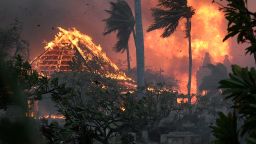Twisted metal. The carcases of burned sedans. Charred shells of what once were homes, thriving businesses and cultural landmarks. As Maui officials continue searching through the wreckage for the many who are still missing after wildfires tore through the island, they have a new tool at hand: human remains detection dogs, often called cadaver dogs.
The wildfires, whipped by strong winds from Hurricane Dora offshore, ravaged the once vibrant Hawaiian island, killing at least 96 people. Only two of the dead have been identified as of Saturday.
The disaster is the deadliest US wildfire in over 100 years, according to research from the National Fire Protection Association. Officials have acknowledged the death toll is likely to increase and the true scale of the casualties is unclear. And spotty cell phone coverage has added to the confusion over missing friends and family.
Cell signals are improving – some families have finally been able to reach their loved ones through text – and Maui County has said that a community center is open to provide resources for people looking for information about missing people.
There were a total of 10 search dogs from the Federal Emergency Management Agency’s Urban Search and Rescue teams in Maui as of Friday, a representative from the agency told CNN, and more are set to join the search effort.
The dogs and their handlers have taken on the harrowing job of searching through the ruins to identify human remains that might be burnt beyond recognition, so authorities can begin the process of matching them with names and notifying families.
Just 3% of the fire zone had been searched with cadaver dogs as of Saturday night, according to Maui Police Chief John Pelletier. “None of us really know the size of” the death toll yet, he told reporters. He urged those with missing family members to contact authorities to coordinate a DNA test to assist in the identification process.
Here’s what else we know.
What are cadaver dogs?
Human remains detection dogs are one of several kinds of working dogs trained to detect scents, like bomb or drug detection dogs.
There are three main types of cadaver dogs: those trained to work in open areas on land, those trained for disasters and collapsed buildings and those that work in water, according to Jason Purgason, the president and training director of Highland Canine Training.
Search dogs are often dogs with a working heritage, like border collies or German shepherds. Lynne Engelbert, a human remains detection dog handler and teacher, told CNN the job requires a specific canine personality. “You have to have a dog that’s got high drive, tenacity, a solid nervous system – that’s willing to go to hell to find what they want and get their reward,” she said.
Once a dog’s been selected, the training process begins. Purgason, who mostly trains dogs for law enforcement and government agencies, said depending on the specialty, training a cadaver dog can take up to eight months.
“We start with a process we call imprinting,” he explained. “And this is simply associating an odor with a reinforcement. So, the dog learns that they find the odor and good things happen,” like a reward of a treat or a toy.
Then the dog learns to notify its owner that it’s found the scent, often by sitting or another signal.
Lisa Briggs, a forensic criminologist who specializes in the use of human remains detection dogs, told CNN not all human remains detection dogs have the same skills – and the dogs in Maui would need to be imprinted specifically on burnt remains in order to search effectively.
“This disaster demonstrates why we need to conduct the science and have the specific proper training in order to be successful,” Briggs said.
A dog’s keen sense of smell
Mary Cablk, a professor emeritus at the Desert Research Institute whose work focuses on canine detection skills, told CNN that cadaver dogs can “go into a structure that is pretty much just ash and metal with a very smoky contaminated background, contamination from the smoke but also the burnt chemicals” and “weed through all that background noise” to find human remains.
Dogs can even identify remains that are so burnt they’re just “grey ash” and impossible for humans to recognize as remains at all, said Cablk.
In an environment like the Maui wildfires, dogs are particularly important because they can search an area non-destructively, preserving evidence that may prove important for an investigation, she added.
“They’re fast, they’re effective – they don’t have the same destructive effect that you and I would have with boots,” she explained. But dogs and their handlers must be specially trained to carefully navigate wildfire environments in a way that preserves evidence and also keeps them safe, said Cablk.
In Maui, the police chief has said that some fragile remains have already been disturbed by people moving through the wreckage. “We pick up the remains and they fall apart,” he said. “And so, when you have 200 people running through the scene yesterday… that’s what you’re stepping on.”
Cablk added that the “loss of infrastructure” will likely pose a major challenge for dogs and their handlers.
“There’s no electricity, there’s no running water, the air is hazardous,” she said. “And then everything gets scaled up in terms of the risk and the hazards.”
Purgason similarly said that the Maui scene is likely a “nightmare” for dogs to work in. “There’s going to be tons and tons of hazards: metal, sharp objects, broken glass,” he noted.
Hawaiian officials should be careful to make sure the dogs are safe while they’re deployed, Briggs said. “You would not send a barefooted human into a burned home with broken glass, chemicals and other sharp or dangerous objects …and neither should dogs be unprotected,” she told CNN. “The dogs will also need to ‘break’ and hydrate often to prevent them from being compromised.”
A crucial partnership
At the heart of a successful search is the partnership between dog and handler, experts told CNN.
“That’s critical,” Purgason said. “If that doesn’t work, nothing works.”
A dog and handler “may work six days straight” for weeks on end, like search teams did in the weeks after Hurricane Katrina, he said. “They have to be pretty closely connected in a lot of different ways.”
“My dogs are not only my best friends but my search partners,” said Engelbert, who has worked to recover human remains with her dogs at disaster scenes including 9/11.
She added that although people sometimes worry about the impact of the work on the dogs, the animals don’t suffer emotional consequences from their searches.
“This is a game for them,” she said. “They’re doing their job – this is what they love to do.”
But, what the handler feels matters – and the work can be extremely challenging for the human end of the partnership. “If the handler gets depressed, what the handler feels, goes right down the leash,” she said.
Purgason, too, noted the job isn’t for everybody: “It takes a special type to do this kind of work.”
For Engelbert, she is motivated by a drive to help families learn the fate of their loved ones and lay them to rest.
Search dogs and their handlers “get to go out into a major disaster and help people one way or the other, whether it’s finding live people if there are or recovering remains,” said Engelbert. “They do that so that their families can move on.”







